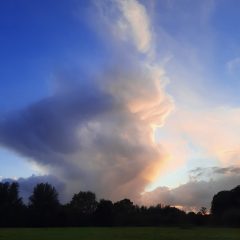An article from my current research project has just been published Open Access with the Review of English Studies, this means that anyone can read it, even if you don’t have an institutional affiliation. The article, ‘The Haunted Island: Medieval History and the Old English Elegies in Brenda Chamberlain’s Tide-race (1962)’, explores the relationship between Brenda Chamberlain’s 1962 memoir Tide-race and medieval literature and culture on Ynys Enlli/Bardsey Island.

Brenda Chamberlain was a fascinating Welsh writer-artist who, after the Second World War and the break-up of her marriage to the artist John Petts, retreated to the remote island of Enlli, where she lived for more than a decade. There were just twelve permanent residents of this remote island at the time, and supplies of food and mail could be completely cut off by the wild currents and bad weather. When Chamberlain published her evocative, dark and surreal memoir about life there in 1962 she was subsequently asked to leave the island by her landlord Lord Newborough. The islanders felt betrayed and exposed by the portrait presented of them in Tide-race, a book which blurs the lines between fact and fiction, and draws on Chamberlain’s visual and verbal work to create a hybrid, protean work.

In my article I reflect on the ethics of this commitment to art over community, and to creativity over connection. The main focus of my discussion though, looks at how Ynys Enlli/Bardsey Island has been constructed as a male, religious space since the early Middle Ages and the work that Chamberlain does in Tide-race to rewrite the island in a different image. In Tide-race the island’s medieval history is erased, subsumed, or submerged, and Chamberlain seeks to weave the silenced voice of the island’s women through the memoir instead. Archival research at the National Library of Wales/Llyfrgell Genedlaethol Cymru, including Chamberlain’s early typescripts for the book, notebooks with sketches and drafts, and correspondence with writers like Roland Mathias, all inform the reading I offer in this article.

Perhaps that’s enough to tempt you to go and have a look at the article, which puts Chamberlain’s early 1960s work of autofiction into dialogue with early medieval poems in Old English like Beowulf, The Wanderer, The Seafarer and The Wife’s Lament! If you want to know more about Ynys Enlli, or how you can visit this incredible island, I recommend taking a look at the Bardsey Island Trust’s website.

